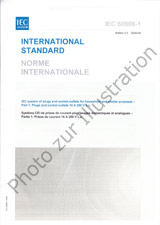Wir benötigen Ihre Einwilligung zur Verwendung der einzelnen Daten, damit Sie unter anderem Informationen zu Ihren Interessen einsehen können. Klicken Sie auf "OK", um Ihre Zustimmung zu erteilen.

IEC 60371-3-5-ed.2.0
Insulating materials based on mica - Part 3: Specifications for individual materials - Sheet 5: Glass-backed mica paper with an epoxy resin binder for post-impregnation (VPI)
Automatische name übersetzung:
Dämmstoffe auf Basis von Glimmer - Teil 3: Bestimmungen für einzelne Werkstoffe - Blatt 5: Glas-und Glimmer, Papier mit einem Epoxidharz Bindemittel für Nachimprägnierung (VPI)
NORM herausgegeben am 21.11.2005
Informationen über die Norm:
Bezeichnung normen: IEC 60371-3-5-ed.2.0
Ausgabedatum normen: 21.11.2005
SKU: NS-410026
Zahl der Seiten: 21
Gewicht ca.: 63 g (0.14 Pfund)
Land: Internationale technische Norm
Kategorie: Technische Normen IEC
Kategorie - ähnliche Normen:
Die Annotation des Normtextes IEC 60371-3-5-ed.2.0 :
IEC 60371-3-5:2005 gives requirements for electrical insulating materials made by combining mica paper with glass fabric and bonding them together with a small amount of epoxy resin. The material is supplied in a flexible state and is designed for use in conjunction with vacuum pressure impregnation (VPI) with compatible impregnates. The final cured properties will be primarily dependent on the VPI resin used. Two bond contents are specified: - low bond with a resin content of (8 ± 3) %; - medium bond with a resin content of (16 ± 3) %. Materials which conform to this specification meet established levels of performance. However, the selection of a material by a user for a specific application should be based on the actual requirements necessary for adequate performance in that application and not based on this specification alone. This second edition cancels and replaces the first edition, published in 1992, and constitutes a technical revision. The main changes with regard to the previous edition include adjustments needed to align this standard with changes included in the latest edition of IEC 60371-2. Keywords: electrical insulating materials, mica paper, glass fabric, vacuum pressure impregnation (VPI) LIEC 60371-3-5:2005 donne les exigences concernant les materiaux isolants electriques obtenus en combinant du papier de mica avec du tissu de verre et en les liant avec une petite quantite de resine epoxyde. Le materiau est fourni dans un etat flexible et est concu pour etre utilise en impregnation sous vide (VPI) avec des produits dimpregnation compatibles. Les proprietes de durcissement finales dependront en premier lieu de la resine VPI utilisee. Deux teneurs en liants sont specifiees: - liaison faible avec une teneur en resine de (8 ± 3) %; - liaison moyenne avec une teneur en resine de (16 ± 3) %. Les materiaux conformes a la presente specification satisfont aux niveaux de performance etablis. Toutefois, il convient que le choix dun materiau par un utilisateur pour une application specifique soit base sur les exigences reelles necessaires aux performances appropriees pour cette application et non base sur cette specification seule. Cette seconde edition annule et remplace la premiere edition parue en 1992 dont elle constitue une revision technique. Les principales modifications par rapport a ledition anterieure incluent des ajustements necessaires pour faire correspondre la presente norme aux modifications de la derniere edition de la CEI 60371-2. Mots cles: materiaux isolants electriques, papier de mica, tissu de verre, impregnation sous vide (VPI)
Ähnliche Normen:
15.2.2007
6.8.2010
29.8.1997
29.9.2009
4.7.2001
5.7.2001
Empfehlungen:
Aktualisierung der technischen Normen
Wollen Sie sich sicher sein, dass Sie nur die gültigen technischen Normen verwenden?
Wir bieten Ihnen eine Lösung, die Ihnen eine Monatsübersicht über die Aktualität der von Ihnen angewandten Normen sicher stellt.
Brauchen Sie mehr Informationen? Sehen Sie sich diese Seite an.



 Cookies
Cookies
